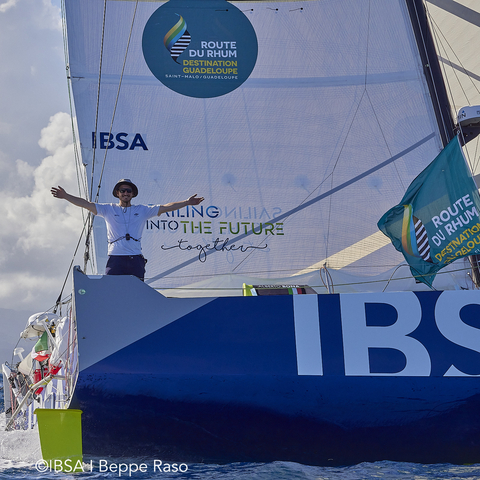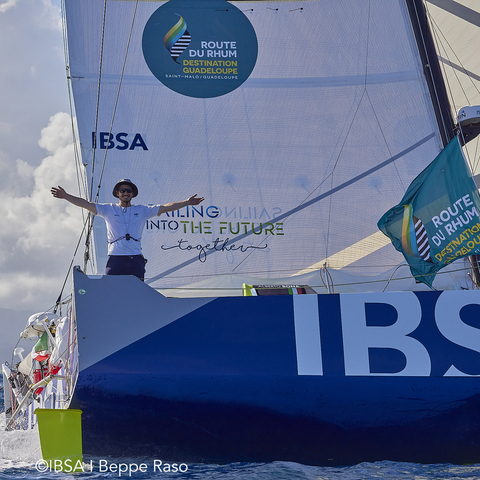POINTE-À-PITRE, Guadeloupe Island--(BUSINESS WIRE)--Thursday, November, 24, at 3:34:50 pm local time (8:34:50 Paris-Rome time) in Pointe-à-Pitre, Alberto Bona on the Class40 IBSA crossed the finish line of the twelfth edition of the Route du Rhum in eighth place. His race time is 15 days, 6 hours, 19 minutes and 50 seconds. The skipper of the Class40 IBSA sailed the 3,542 miles between Saint-Malo and Pointe-à-Pitre at a speed of 9.67 knots on the great-circle course, actually covering 4005.51 miles at an average speed of 10.93 knots. He arrived in Pointe-à-Pitre 1 day, 3 hours, 11 minutes and 10 seconds after the Class40 winner, Yoann Richomme.
“A very nice but extremely hard regatta, especially in the upwind week”, stated Alberto upon arrival. “I am extremely happy: IBSA and I made it together, we crossed an Atlantic that didn’t cut us any slack. A hard, unforgettable experience”.
The Ocean did not make concessions to anyone, but Bona was able to navigate with determination: “In the second disturbance, at night, I lost my wind station, I moved quickly to reach the helm and I hit my head. A tricky moment, no doubt, just like a few days ago when the spinnaker exploded. I replaced it with a bigger one, but the mast then started going down in the water, I had to cool it. Hence the eighth place, which is fine, just as I also know that there is still potential to be expressed”.
Started from Saint-Malo on November 9, the transoceanic regatta – which takes place every four years – saw a total of 138 solo skippers at the start, of whom 55 in Class40. The conditions of this edition proved to be exceptionally complex: after the three-day postponement to avoid a disturbance considered dangerous, the regatta was particularly tough, with an upwind navigation that engaged the Class40s for over a week.
THE BIG UPWIND – After a close-hauled start, the “walkway” in front of the iconic Cap Frehel and a demanding day of sailing already in the Channel, the skippers found themselves at the exit of the English Channel with winds up to 40 knots and rough seas: the Bay of Biscay immediately dictated its own conditions, putting the boats to the test and causing many withdrawals. Alberto Bona, at his first transatlantic regatta in Class40, has always been part of the leading group who – by choosing a more westerly route, far from the European coast – had to face three consecutive disturbances, while always sailing upwind.
It was a very difficult phase of the regatta, as breakdowns and damage affected navigation: Alberto Bona immediately had to deal with the malfunctioning of the main autopilot, due to the failure of the wind station, and this had very harsh consequences, forcing the skipper to spend many hours at the helm, a condition that put to the test his endurance and concentration. During the first days of navigation, Bona also suffered an injury, a cut on his forehead which he treated following the doctor’s instructions by radio.
“Navigating in the upwind conditions we found ourselves in was very difficult”, said Alberto. “It is a situation in which every movement on board is dangerous, and you are forced to remain still as much as possible, so as not to risk banging everywhere. At the same time, it is necessary to be alert, reactive and ready, because the boat has to be monitored and checked continuously, in order to intervene immediately and avoid greater damages”.
The “big upwind” lasted about a week, followed by a few days of wider sailing points and lighter winds: days that Alberto Bona used for what he called “DIY”, that is, a careful analysis of the hull and all the equipment, as well as all the work necessary to restore and prevent any damage.
THE AZORES AND THE CALM – The transition to the Azores, with the Class40 IBSA between the fifth and seventh position, in constant contact with the leaders, proved to be complex as well. The leading group of Class40s, in fact, chose to pass between the islands, gaining speed and miles over the rest of the fleet, but also requiring further attention and control. Then, to the South, the light wind and an uncooperative trade wind, which was late in showing itself, brought the leading group into an area with little wind, which was useful for recovering strength and defining the strategy for the second part of the regatta, characterised by broad reach sailing. In this stage, Alberto attempted a recovery at night, which allowed him to catch up with the leading group when he was about twenty miles behind, but the different weather conditions further along the course favoured the leaders again.
FICKLE TRADE WINDS – However, those who expected welcoming and gentle trade winds were immediately disappointed: the first group of Class40s had to wait longer than expected to catch the carrier winds, discovering that, once they arrived, they would never be steady.
The leaders benefitted from more wind and a better course, thus gaining an additional advantage. The Class40 IBSA showed excellent speed peaks, taking advantage of the moments of stronger wind. In fact, even a few miles away, conditions changed radically and the boats of the leading group sailed with different speeds and directions. Here, Bona tried the “Southern option”, to equalise his chances with the leaders, but the explosion of the heavy gennaker affected the last days of navigation: cross waves and fickle winds literally blew up the sail, and Alberto was left with the option of sailing with a masthead gennaker, to be manoeuvred continuously, but the bigger sail forced the mast into the water several times. To avoid any damage, Bona had to choose a more conservative trim, and the class40 IBSA settled in eighth position.
GUADELOUPE – The Route du Rhum is made up of many regattas within a regatta, and when Guadeloupe is sighted, after 3,500 miles of navigation, the last test begins: the circumnavigation of the island before crossing the finish line in Pointe-à-Pitre. This is the legendary endgame, between lighter winds and the management of navigation along the coast: for Bona it was a long day of navigation, before crossing the finish line in the afternoon and throw himself into the arms of his Cecilia, applauded and surrounded by the affection of the IBSA team, who had arrived in Guadeloupe to give him a warm welcome. Ambrogio Beccaria was also waiting for him on the quay.
“It was an exciting regatta, full of emotions, which kept us in suspense until the end. The Route du Rhum was a challenge for us from all points of view, and we are very proud of Alberto, of the result he achieved and of his excellent performance”, stated Arturo Licenziati, President and CEO of IBSA. “Alberto and the Class40 IBSA showed what is possible thanks to passion, determination and commitment, together with technology and innovation. We can say that both the skipper and his boat have been the perfect interpreters of IBSA’s vision”.
***
THE PROJECT: Sailing into the Future. Together started in January 2022; the partnership between IBSA and Alberto Bona was born on common bases and values, and aims to use sailing as a vehicle for corporate communication, towards the market and the nautical world. Ingenuity, courage, innovation, responsibility are elements that unite IBSA and Alberto, and the challenge of the Route du Rhum, in addition to the sporting race, also metaphorically represents the company’s history, philosophy and vision, which are always oriented towards the future and are part of a path that brings IBSA increasingly closer to the topics of environmental and social sustainability, inclusion and integration. The transatlantic regatta is the first stage of the three-year programme “Sailing Into The Future. Together” that the Swiss pharmaceutical company started with Bona.
THE BOAT: the boat with which Alberto Bona will participate in the Route du Rhum in November is a latest generation Class40, with a scow bow. Designed by French naval architect Sam Manuard and built by the JPS Production shipyard, the boat is a Mach 5 model, the latest evolution of Manuard’s Class40.
The characteristics: rounded bow, created with the aim of increasing performance while running; water lines and appendages designed to make the hull an all-round fast even upwind; large and protected cockpit to face navigation in the most comfortable and safe positions possible.
THE SKIPPER: Alberto Bona is from Turin, and has a degree in philosophy. As a university student, he won the Panerai trophy with Stormvogel, fast ULDB and historic boat with which he crossed the Atlantic Ocean for the first time, winning the ARC with a New Zealand crew. In 2012 he took part in the Minitransat, finishing 5th, one of the best Italian results ever in this category. In 2015 he switched to the prototype category Mini 6.50 with Promostudi La Spezia: he won the Italian championship and finished second in the ocean crossing Les Sables-Azores. In 2017 he discovered the Class40: on Giovanni Soldini’s formerTelecom Italia, he participated in the Transat Jacques Vabres, where he is forced to withdraw when he is in sixth place. In 2019 he was aboard the Maserati Multi 70 trimaran, one of the fastest boats in the world, where he practiced on the foils before moving on to the Figaro Beneteau 3, aboard which he participated in the Solitaire; the only Italian registered, he finished 7th among the rookies in the first year and 16th overall in 2020. In 2021 he won the Italian offshore team title and the Europeans in mixed doubles aboard the Figaro 3. In 2022 he starts the new project, with the support of the IBSA Group.
IBSA: IBSA (Institut Biochimique SA) is a Swiss multinational pharmaceutical Company, founded in 1945 in Lugano. Today, its products are present in over 90 Countries on 5 continents, through the Company’s 17 subsidiaries located in Europe, China, and the United States. The company has a consolidated turnover of 800 million CHF, and employs over 2,000 people between headquarters, subsidiaries and production sites. IBSA holds 90 families of approved patents, plus others under development, as well as a vast portfolio of products, covering 10 therapeutic areas: reproductive medicine, endocrinology, pain and inflammation, osteoarticular, aesthetic medicine, dermatology, uro-gynaecology, cardiometabolic, respiratory, consumer health. It is also one of the largest operators worldwide in the area of reproductive medicine, and one of the world’s leaders in hyaluronic acid-based products. IBSA has based its philosophy on four pillars: Person, Innovation, Quality and Responsibility.




